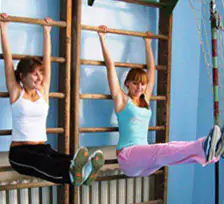The Swedish wall is rightfully considered one of the most effective devices. And not only in bodybuilding and fitness, but also in gymnastics, athletics and other sports disciplines. If you have it at home, then you should definitely use it in your workouts. We bring to your attention several simple, but nevertheless quite effective movements combined into a consolidated complex: Exercises on the Swedish wall for the abs and spine. Most of our readers should be familiar with them from their school days.
Content- Exercise I
- Exercise II
- Exercise III
- Exercise IV
Exercise I
- Take the starting position: grab the bar of the wall bars with both hands. Also, you can use regular gymnastic bars instead (in this case, you should rest your elbows on them).
- Bend your knees slightly and, tensing the muscles of your lower abdomen, pull them towards your shoulders. Fix this position at the top point of the trajectory for a couple of seconds.
- Return to the original position, and then perform the exercise the required number of times.
When performing this movement, make sure that the main load falls on the abdominals, and not on the hip flexors. An indicator of correct performance of this exercise is considered to be raising the pelvis to the chest by about 5-10 cm.
For the exercise to be as effective as possible, your body must remain in a static vertical position, - imagine that your spine from the pelvis to the cervical region is a straight, unbending metal reinforcement. This requirement is considered especially relevant if you replaced the wall bars with bars. In this case, before each new repetition, you need to wait a little until the vibrations of your body completely stop. Also exclude swinging, inertial force and other elements of cheating.
If the exercise is very easy for you, you can do it with weights. To do this, hold a dumbbell between your legs, or use weighted bracelets with Velcro.
By technology his execution This exercise differs practically little from the previous one. The only difference, probably, is that your legs should remain straight. This sports movement is performed as follows:
- Grab the bar of the wall bars with both hands.
- Tightening the muscles of the lower third of the abdomen, raise your straight legs as high as possible. Fix the achieved position at the top point of the amplitude for a couple of seconds.
- Return to the starting position, and then repeat the approach the required number of times.
As already mentioned, your legs should remain completely straight while performing the movement. Due to this, the load significantly increases, and therefore the effectiveness of the training.
Your legs do not have to form a 90° angle with the wall bars: the higher you can raise them, the better.
To perform the following exercises, in addition to the Swedish wall, you will need a gymnastic bench.
Exercise III
- Fix in the starting position: place the gymnastic bench at an angle of approximately 60° to the wall bar, lie on it and grab the bar with both hands.
- Tightening the lower third of your abdominal muscles, slowly lift your legs up and then move them back until your fingertips touch the wall bars.
- Return to the starting position, and then repeat the approach the required number of times.
For increase training effect The legs must be raised absolutely straight. However, as fatigue accumulates or at the initial stage of training, it is allowed to slightly bend them at the knees.
When returning to the starting position, the legs should stop about a centimeter from the bench, without touching it. This significantly increases the load on the muscles.
This exercise, aimed at strengthening the lower third of the abdominal press, is rightfully considered one of the the most effective, but at the same time also the most difficult. It is recommended to perform it fully, however, as soon as you feel pain, it is recommended to stop training.
Exercise IV
- Take the starting position: place the gymnastic bench parallel to the wall bars. Sit on it, secure your feet under the bottom bar and lean back.
- While contracting your upper abdominals, slowly lift your torso up until you are in the maximum position.
- Return to the starting position and repeat this movement as many times as required.
When performing this exercise, a significant load falls not only on the muscles of the lower back and abdominals, but also on the spine. For those for whom this is contraindicated, we can recommend setting up a bench in the same way as described in Exercise III and lying down on it. In this case, when returning to the starting position, the torso should also not touch the bench.
It should also be noted that the key to the effectiveness of your fitness training is not their duration, and their regularity. Therefore, you will achieve better results if you perform one exercise, but every day, than the whole complex at once, but only once a week. Do not despair prematurely if at first you are only able to perform a few repetitions. It's not the quantity that matters, but quality.
Post Views: 129


